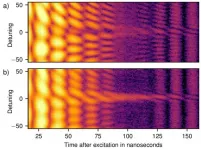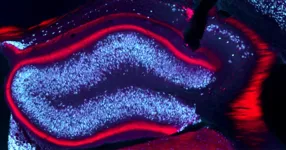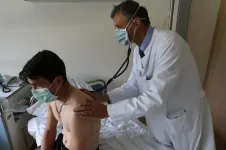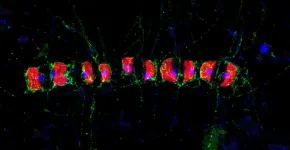INFORMATION:
Swimming upstream on sound waves
2021-02-19
(Press-News.org) At some point, microvehicles that are small enough to navigate our blood vessels will enable physicians to take biopsies, insert stents and deliver drugs with precision to sites that are difficult to reach, all from inside the body. Scientists around the world are currently researching and developing suitable microvehicles. In most cases, they are powered and controlled by acoustic and magnetic fields or using light. However, until now, propelling microvehicles against a fluid flow had proved to be a major challenge. This would be necessary for the micromachines to be able to navigate in blood vessels against the direction of blood flow. Researchers at ETH Zurich have now developed microvehicles that are manipulated by an external field and can swim against the flow.
In their lab experiment, the research team headed by Daniel Ahmed and Bradley Nelson, professors at the Department of Mechanical and Process Engineering of ETH Zurich, used magnetic beads made of iron oxide and a polymer with a diameter of 3 micrometres. A magnetic field induces these particles to cluster into a swarm with a diameter of between 15 and 40 micrometres. The scientists studied the behaviour of this swarm in a thin glass tube with liquid flowing through it. The glass tubes had a diameter of 150 to 300 micrometres, a similar size to the blood vessels in a tumour.
To propel the microswarm against the flow in the tube, the ETH researchers applied the same trick canoeists use on a river: they hug the riverbank to paddle upstream, because the friction of the bank makes the current slower there than in the middle of the river.
Using ultrasound at a specific frequency, the scientists first guided the cluster of microbeads close to the wall of the tube. Then the researchers switched to a rotating magnetic field to propel the swarm against the flow.
As their next step, the researchers intend to investigate how the microvehicles respond in the blood vessels of animals. "As both ultrasound waves and magnetic fields penetrate body tissue, our method is ideal for controlling microvehicles inside the body," says ETH Professor Ahmed.
Microsurgery, such as unclogging blocked blood vessels, is one of the future applications the researchers hope this method will serve. Moreover, the microvehicles could one day be used to deliver cancer drugs to tumours via the blood vessels and release them directly into the tumour tissue. Lastly, another area of application is transferring drugs from blood vessels into the tissues of the brain.
ELSE PRESS RELEASES FROM THIS DATE:
Insight-HXMT gives insight into origin of fast radio bursts
2021-02-19
The latest observations from Insight-HXMT were published online in Nature Astronomy on Feb. 18. Insight-HXMT has discovered the very first X-ray burst associated with a fast radio burst (FRB) and has identified that it originated from soft-gamma repeater (SGR) J1935+2154, which is a magnetar in our Milky Way.
Insight-HXMT is the first to identify the double-spike structure of this X-ray burst as the high energy counterpart of FRB 200428. This discovery, together with results from other telescopes, proves that FRBs can come from magnetar bursts, thus resolving ...
Atomic nuclei in the quantum swing
2021-02-19
From atomic clocks to secure communication to quantum computers: these developments are based on the increasingly better control of the quantum behaviour of electrons in atomic shells with the help of laser light. Now, for the first time, physicists at the Max Planck Institute for Nuclear Physics in Heidelberg have succeeded in precisely controlling quantum jumps in atomic nuclei using X-ray light. Compared with electron systems, nuclear quantum jumps are extreme - with energies up to millions of times higher and incredibly short zeptosecond processes. A zeptosecond is one trillionth of a billionth of a second. The rewards include profound insight into the quantum world, ultra-precise nuclear clocks, ...
Origin of life -- Did Darwinian evolution begin before life itself?
2021-02-19
Before life emerged on Earth, many physicochemical processes on our planet were highly chaotic. A plethora of small compounds, and polymers of varying lengths, made up of subunits (such as the bases found in DNA and RNA), were present in every conceivable combination. Before life-like chemical processes could emerge, the level of chaos in these systems had to be reduced. In a new study, LMU physicists led by Dieter Braun show that basic features of simple polymers, together with certain aspects of the prebiotic environment, can give rise to selection processes that reduce disorder.
In previous publications, Braun's research group explored how spatial order could have developed in narrow, water-filled chambers ...
Deep brain stimulation prevents epileptic seizures in mouse model
2021-02-19
Epileptic activity originating from one or more diseased brain regions in the temporal lobe is difficult to contain. Many patients with so-called temporal lobe epilepsy often do not respond to treatment with anti-epileptic drugs, and the affected brain areas must therefore be surgically removed. Unfortunately, this procedure only gives seizure freedom to about one third of patients, so the development of alternative therapeutic approaches is of great importance. Scientists led by neurobiologist Prof. Dr. Carola Haas, head of the research group at the Department of Neurosurgery at Medical Center - University of ...
COVID-19 may have caused the loss of more than 20.5 million years of life worldwide
2021-02-19
The major direct and indirect effects of covid-19 have forced the authorities to implement policies that strike a balance between minimizing the immediate health impact of the pandemic and containing the long-term damage to society arising from protective policies.
One parameter that is crucial for calculating how restrictive policies might be warranted is the mortality impact of covid-19, which has led to large-scale international collaborations in order to collect data that records deaths attributable to the pandemic.
Despite the limitations, each of these research avenues and associated health measures (infection rate, deaths and excess deaths) is important in order to inform the public and policymakers about the mortality impact of covid-19.
"Our results confirm that the mortality ...
Tuberculosis: New biomarker indicates individual treatment duration
2021-02-19
When can tuberculosis therapy be stopped without risk of relapse? Doctors are faced with this question time and again, because the lack of detection of the tuberculosis pathogen Mycobacterium tuberculosis is no guarantee for a permanent cure of the lung infection. Patients who respond to the standard therapy may be out of treatment after six months. But for resistant cases, more than 18 months of treatment duration is currently advised. "This is a very long time for those affected, who often have to take more than four antibiotics every day and suffer from side effects", explains Prof. Dr. Christoph Lange, Clinical Director at the Research Center Borstel and director of the study, conducted at the German Center for Infection Research (DZIF) in cooperation with the German Center for ...
Communal activities boost rehabilitation for older adults in long term care
2021-02-19
A group of researchers has developed a new program showing participation and activity is critical for the rehabilitation of older adults in long-term care.
The results of their research were published in the journal PLOS ONE on February 12, 2021.
"Our study shows participatory programs that encourage elderly patients to be active need greater emphasis in elderly care centers," said Yoshihiko Baba, lead author of the study.
In 2015, the Ministry of Health, Labour and Welfare of Japan launched a comprehensive plan to care for the country's aging population. Crucial to this was rehabilitation centered on promoting activities that elderly patients could actively take part in.
Baba, a former ...
Animal evolution -- glimpses of ancient environments
2021-02-19
Although amber looks like a somewhat unusual inorganic mineral, it is actually derived from an organic source - tree resins. Millions of years ago, when this aromatic and sticky substance was slowly oozing from coniferous trees, insects and other biological material could become trapped in it. That is why some samples of amber contain fossilized specimens, preserved in a virtually pristine state, which afford fascinating snapshots of the flora and fauna of long-gone forests. Now, a research team led by LMU zoologists Viktor Baranov and Joachim Haug has made exciting ...
An eco-route for heavy-duty vehicles could reduce fuel consumption
2021-02-19
Semi-trucks and other heavy-duty vehicles are responsible for nearly half of road transportation carbon dioxide emissions in Europe, according to the International Council on Clean Transportation. A team of researchers in Italy has proposed a plan to reduce the emissions without compromising priorities such as delivery times. They published their approach in IEEE/CAA Journal of Automatica Sinica, a joint publication of the IEEE and the Chinese Association of Automation.
"Driving style, traffic and weather conditions have a significant impact on vehicle fuel consumption. Road freight traffic, in particular, contributes ...
Sweet marine particles resist hungry bacteria
2021-02-19
A major pathway for carbon sequestration in the ocean is the growth, aggregation and sinking of phytoplankton - unicellular microalgae like diatoms. Just like plants on land, phytoplankton sequester carbon from atmospheric carbon dioxide. When algae cells aggregate, they sink and take the sequestered carbon with them to the ocean floor. This so called biological carbon pump accounts for about 70 per cent of the annual global carbon export to the deep ocean. Estimated 25 to 40 per cent of carbon dioxide from fossil fuel burning emitted by humans may have been transported by this process from the atmosphere to depths below 1000 meter, where carbon can be stored for millennia. ...




